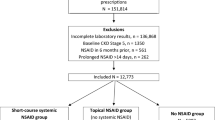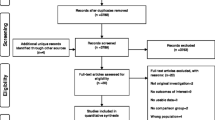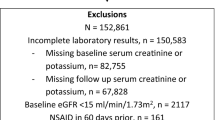Abstract
Background
Topical non-steroidal anti-inflammatory drugs (NSAIDs) have lower risks for cardiovascular disease and gastrointestinal adverse effects compared to oral NSAIDs, but there are little data regarding their kidney risks in chronic kidney disease (CKD). We evaluated the risk of adverse acute kidney outcomes in CKD according to route of NSAID administration.
Methods
Retrospective cohort study of adults with CKD (eGFR less than 60 ml/min/1.73 m2) who received prescriptions between 2015 and 2017 from a major healthcare cluster in Singapore. The adverse acute kidney outcomes were acute kidney injury (AKI) and need for nephrology specialist consult within 30 days.
Results
Among 6298 adults with CKD (mean age 72.1 ± 13.3 years and eGFR 41.9 ± 12.2 ml/min/1.73 m2), systemic and topical NSAIDs were prescribed in 16.7% and 32.0%, respectively. Incident AKI (any severity), KDIGO Stage 2 or 3 AKI, and need for nephrology specialist consult occurred in 16.7%, 2.6%, and 10.6% of the study cohort, respectively. After adjusting for age, diabetes, recent cardiovascular hospitalization, baseline eGFR, RAAS blocker and diuretic, systemic NSAIDs, and topical NSAIDs, compared with the no-NSAID group, were independently associated with incident AKI [adjusted OR 1.77 (95% CI 1.46–2.15) and 1.38 (1.18–1.63), respectively]. Moderate and severe AKI (adjusted OR 1.68, 95% CI 1.09–2.58, p = 0.02) and need for nephrology consults (adjusted OR 1.41, 95% CI 1.09–1.82, p = 0.008) were also increased in systemic NSAIDs.
Conclusion
Among adults with CKD, both systemic and topical NSAIDs were independently associated with acute adverse kidney outcomes.

Similar content being viewed by others
Data availability
The data that support the findings of this study are available on request from the corresponding author. The data are not publicly available, because data sharing will be subject to institutional approval.
References
Tuttle KR, Alicic RZ, Duru OK et al (2019) Clinical characteristics of and risk factors for chronic kidney disease among adults and children: an analysis of the CURE-CKD registry. JAMA Netw Open 2(12):e1918169–e1918169
Davison SN, Rathwell S, George C, Hussain ST, Grundy K, Dennett L (2020) Analgesic use in patients with advanced chronic kidney disease: a systematic review and meta-analysis. Can J Kidney Health Dis 7:2054358120910329
Lefebvre C, Hindié J, Zappitelli M, Platt RW, Filion KB (2019) Non-steroidal anti-inflammatory drugs in chronic kidney disease: a systematic review of prescription practices and use in primary care. Clin Kidney J 13(1):63–71
Zhang X, Donnan PT, Bell S, Guthrie B (2017) Non-steroidal anti-inflammatory drug induced acute kidney injury in the community dwelling general population and people with chronic kidney disease: systematic review and meta-analysis. BMC Nephrol 18(1):256
Orlandi PF, Fujii N, Roy J et al (2018) Hematuria as a risk factor for progression of chronic kidney disease and death: findings from the Chronic Renal Insufficiency Cohort (CRIC) Study. BMC Nephrol 19(1):150
Heyneman CA, Lawless-Liday C, Wall GC (2000) Oral versus topical NSAIDs in rheumatic diseases. Drugs 60(3):555–574
Lin TC, Solomon DH, Tedeschi SK, Yoshida K, Kao Yang YH (2017) Comparative risk of cardiovascular outcomes between topical and oral nonselective NSAIDs in Taiwanese patients with rheumatoid arthritis. J Am Heart Assoc. https://doi.org/10.1161/JAHA.117.006874
Makris UE, Kohler MJ, Fraenkel L (2010) Adverse effects of topical nonsteroidal antiinflammatory drugs in older adults with osteoarthritis: a systematic literature review. J Rheumatol 37(6):1236
Lim C, Choo J, Kwek JL, Abdul Kadir H, Tan NC (2021) Non-steroidal anti-inflammatory drug prescription in the young-old and very-old: type, route and burden of cardiovascular risk factors. Nephrol Dialysis Transplant. 36(Supplement_1):gfab092.0065
Terrill M, Soden M, Srivastava V (2020) Survey of Australasian Renal and Rheumatology Specialists investigating topical NSAID use and adverse renal outcomes. Musculoskeletal Care 18(2):134–139
Fernando AH, Thomas S, Temple RM, Lee HA (1994) Renal failure after topical use of NSAIDs. BMJ (Clin Res ed) 308(6927):533–533
Andrews PA, Sampson SA (1999) Topical non-steroidal drugs are systemically absorbed and may cause renal disease. Nephrol Dialysis Transplant 14(1):187–189
Lim CC, Ang ATW, Kadir HBA et al (2020) Short-course systemic and topical non-steroidal anti-inflammatory drugs: impact on adverse renal events in older adults with co-morbid disease. Drugs Aging 38:147–156
Levey AS, Stevens LA, Schmid CH et al (2009) A new equation to estimate glomerular filtration rate. Ann Intern Med 150(9):604–612
Nash DM, Markle-Reid M, Brimble KS et al (2019) Nonsteroidal anti-inflammatory drug use and risk of acute kidney injury and hyperkalemia in older adults: a population-based study. Nephrol Dialysis Transplant. 34:1145–1154
Kellum JA, Lameire N, Aspelin P et al (2012) Kidney disease: improving global outcomes (KDIGO) acute kidney injury work group. KDIGO clinical practice guideline for acute kidney injury. Kidney Int Suppl 2(1):1–138
Schneider V, Lévesque LE, Zhang B, Hutchinson T, Brophy JM (2006) Association of selective and conventional nonsteroidal antiinflammatory drugs with acute renal failure: a population-based, nested case-control analysis. Am J Epidemiol 164(9):881–889
Lapi F, Azoulay L, Yin H, Nessim SJ, Suissa S (2013) Concurrent use of diuretics, angiotensin converting enzyme inhibitors, and angiotensin receptor blockers with non-steroidal anti-inflammatory drugs and risk of acute kidney injury: nested case-control study. BMJ (Clin Res ed). 346:e8525
Chou C-I, Shih C-J, Chen Y-T et al (2016) Adverse effects of oral nonselective and cyclooxygenase-2-selective NSAIDs on hospitalization for acute kidney injury: a nested case–control cohort study. Medicine 95(9):e2645
Horl WH (2010) Nonsteroidal anti-inflammatory drugs and the kidney. Pharmaceuticals (Basel, Switzerland) 3(7):2291–2321
Williams AW, Dwyer AC, Eddy AA et al (2012) Critical and honest conversations: the evidence behind the “Choosing Wisely” campaign recommendations by the American Society of Nephrology. Clin J Am Soc Nephrol CJASN 7(10):1664–1672
Szeto C-C, Sugano K, Wang J-G, et al (2020) Non-steroidal anti-inflammatory drug (NSAID) therapy in patients with hypertension, cardiovascular, renal or gastrointestinal comorbidities: joint APAGE/APLAR/APSDE/APSH/APSN/PoA recommendations. Gut
Ingrasciotta Y, Sultana J, Giorgianni F et al (2015) Association of individual non-steroidal anti-inflammatory drugs and chronic kidney disease: a population-based case control study. PLoS ONE 10(4):e0122899
Zhan M, Doerfler RM, Xie D, et al (2020) Association of opioids and nonsteroidal anti-inflammatory drugs with outcomes in CKD: findings from the CRIC (Chronic Renal Insufficiency Cohort) Study. Am J Kidney Dis
Katsuno T, Togo K, Ebata N et al (2021) Burden of renal events associated with nonsteroidal anti-inflammatory drugs in patients with osteoarthritis and chronic low back pain: a retrospective database study. Pain Ther 10:443–455
Dreischulte T, Morales DR, Bell S, Guthrie B (2015) Combined use of nonsteroidal anti-inflammatory drugs with diuretics and/or renin–angiotensin system inhibitors in the community increases the risk of acute kidney injury. Kidney Int 88(2):396–403
Schjerning A-M, McGettigan P, Gislason G (2020) Cardiovascular effects and safety of (non-aspirin) NSAIDs. Nat Rev Cardiol 17:1–11
Navaneethan SD, Schold JD, Arrigain S, Jolly SE, Nally JV (2015) Cause-specific deaths in non–dialysis-dependent CKD. J Am Soc Nephrol 26(10):2512–2520
Chertow GM, Lee J, Kuperman GJ et al (2001) Guided medication dosing for inpatients with renal insufficiency. JAMA 286(22):2839–2844
Yamamoto T, Nakayama I, Kawakatsu Y et al (2019) Effects of pharmacist participation in chronic kidney disease (CKD) network and CKD manual distribution on drug-related kidney injury. Pharmacoepidemiol Drug Saf 28(6):887–896
Martin M, Wilson FP (2019) Utility of electronic medical record alerts to prevent drug nephrotoxicity. Clin J Am Soc Nephrol 14(1):115–123
Pham PC, Khaing K, Sievers TM et al (2017) 2017 update on pain management in patients with chronic kidney disease. Clin Kidney J 10(5):688–697
Persons O (2009) Pharmacological management of persistent pain in older persons. J Am Geriatr Soc 57(8):1331–1346
Novick TK, Surapaneni A, Shin J-I et al (2018) Prevalence of opioid, gabapentinoid, and NSAID use in patients with CKD. Clin J Am Soc Nephrol 13(12):1886–1888
Muanda FT, Weir MA, Ahmadi F et al (2022) Higher-dose gabapentinoids and the risk of adverse events in older adults with CKD: a population-based cohort study. Am J Kidney Dis 80(1):98-107.e101
Agoritsas T, Merglen A, Shah ND, O’Donnell M, Guyatt GH (2017) Adjusted analyses in studies addressing therapy and harm: users’ guides to the medical literature. JAMA 317(7):748–759
Signorello LB, McLaughlin JK, Lipworth L, Friis S, Sørensen HT, Blot WJ (2002) Confounding by indication in epidemiologic studies of commonly used analgesics. Am J Ther 9(3):199–205
Secrest MH, Platt RW, Dormuth CR et al (2020) Extreme restriction design as a method for reducing confounding by indication in pharmacoepidemiologic research. Pharmacoepidemiol Drug Saf 29:26–34
Acknowledgements
We thank the SingHealth Health Services Research Center for providing de-identification service and the SingHealth Research Office for administrative support.
Funding
This research was supported by the SHF-Foundation Research Grant (SHF/HSRHO014/2017).
Author information
Authors and Affiliations
Contributions
All authors contributed to and approved the final version of this manuscript for submission.
Corresponding author
Ethics declarations
Conflict of interest
All authors declare no relevant conflict of interest.
Ethics approval
For manuscripts that report the results of a clinical trial, a statement confirms that the study was approved (or granted exemption) by the appropriate institutional and/or national research ethics committee (including the name of the ethics committee) and certifying that the study was performed in accordance with the ethical standards as laid down in the 1964 Declaration of Helsinki and its later amendments or comparable ethical standards.
Consent
Waiver of informed consent for use of de-identified electronic medical record data was approved by the SingHealth Centralized Institutional Review Board (2018/2567).
Additional information
Publisher's Note
Springer Nature remains neutral with regard to jurisdictional claims in published maps and institutional affiliations.
Supplementary Information
Below is the link to the electronic supplementary material.
Rights and permissions
Springer Nature or its licensor holds exclusive rights to this article under a publishing agreement with the author(s) or other rightsholder(s); author self-archiving of the accepted manuscript version of this article is solely governed by the terms of such publishing agreement and applicable law.
About this article
Cite this article
Teo, S.H., Tan, N.C., Choo, J.C.J. et al. Non-steroidal anti-inflammatory drugs in chronic kidney disease and risk of acute adverse kidney events according to route of administration. Int Urol Nephrol 55, 679–686 (2023). https://doi.org/10.1007/s11255-022-03344-9
Received:
Accepted:
Published:
Issue Date:
DOI: https://doi.org/10.1007/s11255-022-03344-9




